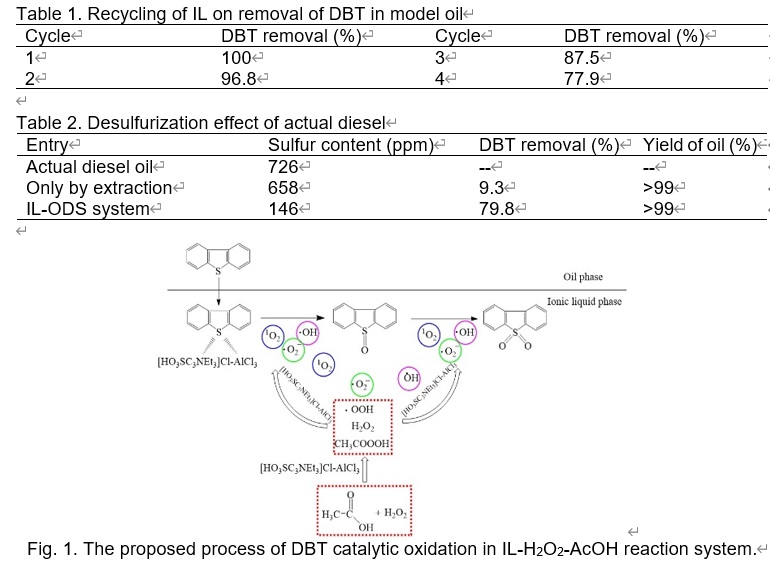(379k) Catalytic Oxidation Desulfurization of Dibenzothiophene By Bronsted-Lewis Acid Ionic Liquids
AIChE Annual Meeting
2024
2024 AIChE Annual Meeting
Fuels and Petrochemicals Division
Poster Session: Fuels and Petrochemicals Division
Tuesday, October 29, 2024 - 3:30pm to 5:00pm
Materials and Methods: 1,3-propanesultone, HCl, triethylamine, acetone, anhydrous ZnCl2, anhydrous FeCl3, anhydrous AlCl3, anhydrous CuCl2, H2O2, n-octane, dibenzothiophene, glacial acetic acid, isopropanol, 1,4-benzoquinone, 4-amino-2,2,6,6-tetramethylpiperidine and 5,5-dimethyl-1-pyrroline N-oxide. For the desulfurization experiment, 10 mL model oil or actual diesel mixed with certain amount of ILs, H2O2 and AcOH were added into a three-necked flask under vigorous stirring for reacting a certain time, and using oil bath to adjust the different reaction temperature. During the reaction, the sulfur content in upper phase was periodically separated and detected by sulfur analyzer. The sulfur content was measured by THA-2000S Ultraviolet Fluorescence Sulfur Analyzer. And the sulfur types were detected by GC-FPD.
Results and Discussion: The effect of DBT removal by four ILs was investigated. The results showed that the catalytic activity of the four ILs followed the order of [HO3SC3NEt3]AlCl4 > [HO3SC3NEt3]ZnCl3 >> [HO3SC3NEt3]FeCl4 > [HO3SC3NEt3]CuCl3. In the two-phase oxidation desulfurization system, a very small amount of [HO3SC3NEt3]AlCl4 showed a remarkable catalytic ability for the oxidation of dibenzothiophene (10 mL model oil with 1000 ppm sulphur content, 1mL H2O2, 2mL acetic acid, 55℃, 20min, 0.25g IL. According the analysis of the potential ROSs by quenching experiments and Electron Paramagnetic Resonance (EPR). There are three types of ROSs, 1O2,•OH, and •O2―, in the system were detected. The desulfurization system can be recycled 4 times without noticeable decrease in activity (Table 1). [HO3SC3NEt3]AlCl4 showed excellent recycling performance. This IL-ODS system was applied to actual diesel and achieved a good desulfurization effect (Table 2). In summary, Among these four ILs, [HO3SC3NEt3]AlCl4 shows a remarkable catalytic activity. The EPR detection and quenching experiments verify the 1O2 is in charge of the oxidation of DBT. IL is not only to promote the generation of ROSs in the reaction system, but also to act as a reaction medium between the oxidants and sulfides. The process and mechanism for catalytic oxidation of DBT in IL-ODS system was proposed in Fig. 1.
